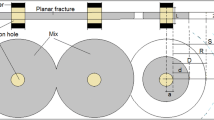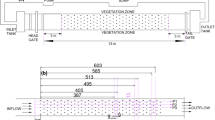Abstract
Some of the basic assumptions of the Advection-Dispersion model, AD-model, are revisited. That model assumes a continuous mixing along the flowpath similar to Fickian diffusion. This implies that there is a constant dispersion length irrespective of observation distance. This is contrary to most field observations. The properties of an alternative model based on the assumption that individual water packages can retain their identity over long distances are investigated. The latter model is called the Multi-Channel model, MCh-model. Inherent in the latter model is that if the waters in the different pathways are collected and mixed, the “dispersion length” is proportional to observation distance.
Using diffusion theory it is investigated over which distances or contact times, adjacent water packages will keep their identity. It is found that for a contact time of 10 hours, two streams, each wider than 6 mm, that flow side by side, will not have lost their identity. For 1000 hours contact time the minimum width is 6 cm.
The MCh and AD-models were found to have very similar Residence Time Distributions, RTD, for Peclet numbers larger than 3. A generalized relation between flowrate and residence time is developed, including the so-called cubic law and constant aperture assumptions. Using the generalized relation, surprisingly it is found that for a system that has the same average flow volume and average flowrate the form of the RTD curves are the same irrespective of the form of the relation.
Both models are also compared for a system where there is strong interaction of the solute with the rock matrix. In this case it is assumed that the solute can diffuse into and out of the fracture walls and also to sorb on the micro-fractures of the matrix. The so-called Flow Wetted Surface, FWS, between the flowing water in the fracture and the rock is a key entity in such systems. It is found that the AD-model predicts much later arrivals and lower concentrations than does the MCh-model for strongly sorbing solutes.
The conditions are explored for when in-filling particles in the fracture will not be equilibrated but will act as if there was seemingly a much larger FWS. It is found that for strongly sorbing tracers, relatively small particles can act in this way for systems and conditions that are typical of many tracer tests.
Conditions for when uptake into stagnant zones of water in the fracture itself could be important are also explored. It is found that this mechanism can be quite important in fractures with large apertures.
The assumption that the tracer residence time found by cautiously injecting a small stream of traced water represents the residence time in the whole fracture is explored. It is found that the traced stream can potentially sample a much larger fraction of the fracture than the ratio between the traced flowrate and the total pumped flowrate. In some recent field experiments the visually observed fracture apertures indicate that this may well be the case and possibly a more than two times larger fraction of the fracture is sampled than the flow rate ratio would indicate. This of course has an impact on the Flow Wetted Surface the traced stream contacts.
The MCh-model was used to simulate some recent tracer tests in a single fracture at the ÄSPÖ Hard rock laboratory in Sweden. Non-sorbing tracers, HTO and Uranin were used to determine the mean residence time and its variance. Laboratory data on diffusion and sorption properties were used to “predict” the RTD of the sorbing tracers. It was found that diffusion into stagnant zones of water in the fracture could be 10 to 300 times larger than the uptake into the rock matrix in these experiments. This was also found to give good agreement with the experiments for the non sorbing and weakly sorbing tracers. For the strongly sorbing tracers it was necessary to invoke a 2-6 times stronger interaction with the material in the stagnant zones than expected. Some reasons for such behavior are explored.
The transmissivity variance found from the five bore-holes intersecting the fracture where the tracer experiments were made were used to determine the exponent in the generalized relation between aperture and flowrate. The equivalent to the exponent 3 in the cubic law was found to be 1.3-1.6.
Similar content being viewed by others
References
Lallemand-Barres A., Peaudecerf P. Recherche des relations entre la valeur de la dispersivité macroscopique d’un milieu aquifère, ses autres caractéristiques et les conditions de mesure, Bull. BRGM (2) III, 4, 277, 1978
Matheron G., and de Marsily G., “Is transport in porous media always diffusive? A counterexample,” Water Resources Res. 6, p. 90, 1980
Neretnieks I., Prediction of radionuclide migration in the geosphere. - Is the porous flow model adequate? International symposium on migration in the terrestrial environment of long-lived radionuclides from the nuclear fuel cycle; IAEA symposium, Knoxville, Tennessee, USA, July 1981, IAEA - SM - 257/49, p 635–657, 1981.
Neretnieks I. A note on fracture flow mechanisms in the ground, Water Resources Res. 19, p. 364–370, 1983
Gelhar L.W., Mantoglou A., Welty C., Rehfeldt K.R. A review of field scale physical solute transport processes in saturated and unsaturated media, EPRI EA-419OS, Aug 1985
Neretnieks I. Solute Transport in Fractured Rock- Applications to Radioactive Waste Repositories. Chapter 3. Ed Bear J., de Marsily G., Tsang C-F. Press Academic p 39–127, 1993
Schweich D. Transport of linearly reactive solutes in porous media. Basic models and concepts. In “Migration and fate of pollutants in soils and subsoils.” Ed. Petruzzelli D. and Helfferich F.G. NATO ASI series, Vol G 32. p 221–245, Springer Verlag 1993
Turcotte D.L. Fractals and Chaos in Geology and Geophysics, Cambridge University Press, 2nd Ed. 1997
Chesnut D.A. Dispersivity in heterogeneous media. Lawrence Livermore National Laboratory, UCRL-JC-114790 January 1994. daches@earthlink.net
Neretnieks I., Eriksen T., Tähtinen P. “Tracer movement in a single fissure in granitic rock: Some experimental results and their interpretation,” Water Resources Res. 18, p 849, 1982
Moreno L., Neretnieks I., Eriksen T. Analysis of some laboratory tracer runs in natural fissures, Water Resources Res. 21, p 951–958, 1985
Abelin H., Birgersson L., Gidlund J., Neretnieks I. A Large Scale Flow and Tracer Experiment in Granite I. Experimental Design and Flow Distribution. Water Resources Research, 27, p 3107–3117, 1991a
Abelin H., Birgersson L., Moreno L., Widén H., Ågren T., Neretnieks I. A Large Scale Flow and Tracer Experiment in Granite II. Results and interpretation. Water Resources Research, 27, p 3119–3135, 1991b
Carslaw H.S., Jaeger J.C. Conduction of heat in solids, 2nd ed. Oxford University press 1959
Neretnieks I., Diffusion in the rock matrix: An important factor in radionuclide retardation? J. Geophys. Res. 85, p 4379–4397, 1980.
Neretnieks I., Rasmuson A. An approach to modelling radionuclide migration in a mediaum with strongly varying velocity and block sizes along the flowpath. Water Resources Res. h 20, p 1823–1836. 1984
Winberg A., Andersson P., Hermanson J., Byegård J., Cvetkovic V., Birgersson L. Final report of the first stage of the tracer retention understanding experiments, Technical Report, TR 00-07, Äspö Hard Rock Laboratory. March 2000.
Byegård J., Johansson H., Skålberg M. The interaction of sorbing and non-sorbing tracers with different Åspö rock types. Sorption and diffusion experiments in the laboratory scale. SKB Technical Report TR 98-18, Nov 1998.
Author information
Authors and Affiliations
Rights and permissions
About this article
Cite this article
Neretnieks, I. Revisiting the Advection-Dispersion Model Testing an Alternative. MRS Online Proceedings Library 663, 1043 (2000). https://doi.org/10.1557/PROC-663-1043
Published:
DOI: https://doi.org/10.1557/PROC-663-1043




